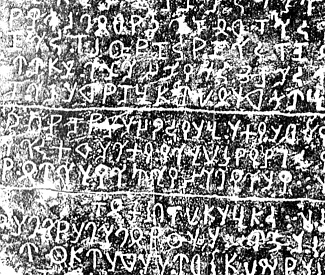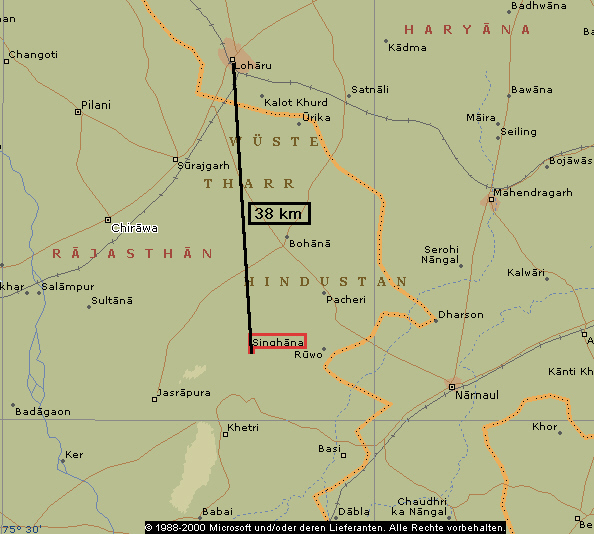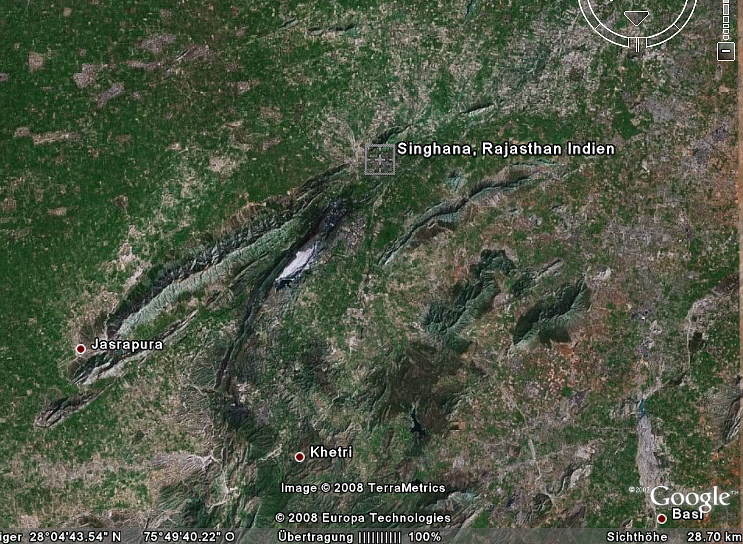

Zitierweise / cite as:
On the Copper Works at Singhana near Khetri in the Shekhawati Country (1831). -- (Quellenkunde zur indischen Geschichte bis 1858 / Alois Payer ; 4. Münzen, 1.). -- Fassung vom 2008-04-11. -- http://www.payer.de/quellenkunde/quellen042.htm
Erstmals publiziert in:
Gleanings in Science. -- Dec. 1831. -- pp. 80-84.
Abgedruckt in:
A source-book of Indian archaeology / ed. by F. Raymond Allchin .... -- New Delhi : Manoharlal. -- Vol. 2: Settlements, technology and trade. - 1997. - VII, 708 S. -- S. 470 - 474. -- Hier nach diesem Nachdruck wiedergegeben.
Erstmals hier publiziert: 2008-04-11
Überarbeitungen:
Anlass: Lehrveranstaltung FS 2008
©opyright: Public Domain
Dieser Text ist Teil der Abteilung Sanskrit von Tüpfli's Global Village Library
Falls Sie die diakritischen Zeichen nicht dargestellt bekommen, installieren Sie eine Schrift mit Diakritika wie z.B. Tahoma.
Anonymous
On the Copper Works at Singhana near Khetri in the Shekhawati Country

Abb.: Lage von Singhāna
[©MS Encarta]
The mines whence the copper ore is extracted are situated one kos
[3.2 km] south-west
from Singhana, in the range of rocky hills which run for some distance to the
southward of that town, and seem to be impregnated with metallic ore throughout
their whole extent; mines are also wrought at Khetri and Bubai, producing many
valuable minerals, such as copper, tamba; blue vitriol or sulphate of copper,
called by the natives lila tutia, or leelo toto; alum, phitkari, and a mineral
called sehta, which requires a more particular description.
This sehta looks like a fine grey sand, having the appearance of iron-fillings
mixed with minute particles of silex and mica; its value, at the mines, being
from 40 to 100 rupees per maund [12,6 kg]. It is only produced at Bubai, and is used as an
ingredient in making
glass, kanch, or women's wrist-ornaments, chura, which seem to be made of a
vitrified substance, coloured with lac, lah, and other pigments.

Abb.: Singhāna
[Bildquelle ©Google Earth. -- Zugriff am 2008-04-11]
To return however to the copper mines at Singhana. On approaching the rocky ridge in which those excavations have been carried on for many generations, the openings of numerous shafts may be observed, giving access to the galleries by which the hills are honey-combed in every direction, to the length of a kos [3.2 km], if the natives are to be believed. These shafts descend in a very irregular manner, but to a considerable depth; their sides being notches and cut in such a way as to allow for ingress and egress without the help of ladders, and their section seems to be a rude oval about 5 feet by 4 [1,5 x 1,2 m], or 4 by 3 feet [1,2 x 0,9 m] . When the shafts have reached a sufficient depth, galleries are driven out in various directions to follow the veins of ore, which are embedded in a very hard matrix, and the following device is resorted to in order to facilitate the operation of extracting the metal.
At the head of the mine, kan, a quantity of firewood is collected, and stacked in a compact manner to the amount of 150 or 200 maunds [1900 bis 2500 kg], which being set on fire, the miners make their escape as fast as they can, to avoid the chance of their being smothered in the gallery, for some fatal accidents are said to have happened in this manner. On the third day, the workmen descend into the mine and find that the interior of the rock has been rent and split into huge masses by the violence of the heat; and they then proceed, if the mine be sufficiently cooled, to carry on the drift in the following manner.
Each labourer is provided with a lamp, diya; a hammer, hatori; a mining chisel or gad, tanki; and a small wicker basket, tokri. The lamp is placed upon the workman's head, and not only affords light for the execution of his work, but enables him also by watching the glittering particles of metal, to detach only such portions of the ore as may promise to give him the best remuneration for his labour. While at work he seats himself upon his heels, with the lamp upon his head as above-mentioned; the hammer is in his right hand, the gad in his left, and the little basket upon his knees, in which he receives all the fragments of ore that are struck off by the chisel.
The very confined posture in which the miners are obliged to work, and the exceeding heat and closeness of the galleries, together with the want of fresh air, render their lives almost a constant round of painful toil, and they may be fairly said to live entirely "by the sweet of their brow;" their almost naked bodies are constantly bathed in perspiration, and their breathing is very laborious; their constitutions in short are said to be so quickly broken up by this pernicious employment that they commonly die at the ages of 35 and 40 years. Their fixed wages are two annas a day, for which however they are only obliged to furnish one basket full of ore; an industrious man can earn much more, as he receives an extra sum for any additional quantity he may furnish over and above the regular quantum; and by this means he can give himself a holiday once in 8 or 9 days.
I have been informed, that the mines are only wrought during eight months in each year, from about the festival of Dasera, at the beginning of October, to the setting in of the rains, after which time a considerable quantity of water filters into them, and is again baled out at the commencement of the ensuing season. The labourers are also obliged to work during the night, discontinuing their employment early in the morning, or the excessive heat might otherwise be fatal to them:1 I have however seen those labourers, many of whom are Muselmans, coming from the mines in the evening, with their little basket of ore and mining implements, apparently just relieved from their task; but this may perhaps be owing to the unusual fineness of the season, as the hot winds have not set in, which is an extraordinary circumstance at the end of April. When the day's work is completed, the miners return home with the proceeds of their labour, which is collected at a public chabutra near the smelting furnaces, mandari, of Singhana, and is there sold in retail, by auction, to the proprietors of the different furnaces, of which only seven or eight are now at work.
As I have not the means of giving an accurate mineralogical description of the copper ore, nor of the rock whence it is obtained, numerous specimens of the former have been procured for the purposes of chemical analysis by some one is better acquainted with the subject: it will perhaps be sufficient in this place to say, that its mineral character appears very simple; its structure is laminar, and nearly all the specimens present a hard quartzose matrix of a grey colour, thickly interspersed with bright metallic particles of a golden colour, whence the natives call it sona-mukhi, and they made use of this substance as a collyrium for the eyes. It is procured in small lumps the size of an almond, or of a small hazel-nut, and being grated or rubbed into powder upon another stone, it is then applied to the eyes, like the ore of antimony, surma, though rather medicinally than as a cosmetic.
When brought from the mines, the copper ore, dhat, is partly in small shingles of a few ounces weight, partly in nodular fragments of various sizes, from a walnut to a pea, and partly in a states of dust or powder; and the whole of it must be reduced to this condition before the operation of roasting is commenced. A heavy stone anvil, sil, is bedded in the floor of the triturating shop, a little below the level of the ground, which is hollowed out and paved so as to form a small basin, 2 or 3 feet in diameter; which with a heavy iron hammer, ghan, weighing 8 or 10 seers [7 bis 10 kg], forms the whole apparatus of the Crushing Mill.
The operator sits on the edge of this hollow, with his feet resting on the anvilhead, and as both hands are required to manage the sledge-hammer his toes are employed in raking together the particles of ore which require to be pounded, and in cautiously thrusting them toward the spot on which the hammer descends. The handle of this tool projects sufficiently towards the front to allow of a fair grasp for the right hand, which assists the left hand in raising it far above the head, and it is then brought down with great force between the feet, so that this must be a very laborious operation, and is only performed by able bodied men who receive 4 rupees per mensem; women and even children are employed in other parts of the process to be described hereafter.
When the ore has been thoroughly pounded, it is sifted, and the coarser parts of it are again passed under the hammer, until reduced to a powder sufficiently fine to be employed in the second part of the operation, which is this: A quantity of cow-dung, gobar, is kneaded up with the pounded mineral, in the proportion of 5½ maunds of the latter to 1½ of the former, and it is then moulded by the hands into small sausage-shaped masses, pindi, about 5 inches [13 cm] long and 1¼ inches [3 cm] in diameter, which are all laid out in regular order to be dried by the sun previously to their being burned in the kiln. After they are sufficiently dry, they are stacked into small circular heaps, forming the segment of a sphere, about 4 feet [1,2 m] broad and 1½ feet [0,5 m] high; which is covered with a single layer of dried cow-dung cakes, upla, or kanda: and being set on fire during the evening, it is left to burn all night.
1 We should have thought that the temperature would remain constant day and nightEd.
In the morning, when the kiln is cool, the burned pindis (which are now of a red colour) are carefully separated from the white ashes, and are set aside for the smelting furnace, which is now being prepared, as the forge requires to be rebuilt every morning. The refuse of the kiln is also carefully collected and formed into balls, the size of a large orange, that nothing may be wasted.
In preparing the blast furnace, mandari, a quantity of common sand is first spread upon the floor of a circular hut, in the centre of which is formed a small hollow, of the shape and size of a common brass kneading-dish, thali that is to say 12 or 15 inches [30 - 40 cm] in diameter and 2 or 3 inches [5 - 8 cm] deep. In this is first laid a stratum of fine yellow sand, and then another of ashes, rakh, to prevent the melted metal from adhering to the bottom of the receiver. Two clay nozzles, mus, are then placed on opposite sides of this shallow pan, and a third one between them, leaving the fourth side vacant to allow the melted dross to escape.
A quantity of moist clay is at hand, with which these nozzles are connected
together, and a little mud wall is built a few inches in height to serve a
basement for the three vessels of fireclay (a,a,a) which are placed upon one
another to form the body of the furnace.
Each of these annular vessels called kothi, is about 15 inches [40 cm] in exterior
diameter, 9 or 10 inches [25 cm] high, and perhaps 3 inches [8 cm] in thickness. They are used
over and over again, but the lower portion of the furnace requires to be renewed
daily as above-mentioned. Three ordinary Hindustani bellows, phonkni, of goat
skin, are attached to the other end of each nozzle, and are worked by men,
women, or even children. Before the furnace is loaded, a quantity of charcoal is
burned within the chamber (b,) in order to drive out all moisture from the newly
moulded clay receiver. The fire is poked at times through the openings (c, c,)
which are then closed again with moist clay.
The quantity of materials which a single furnace will consume during a day of 3 or 3½ pahirs, (9 or 10 hours,) is said to be 3 maunds [38 kg] of charcoal and 2½ maunds [30 kg] of the pindis formerly described, to which are added 2 or 3 maunds [35 - 35 kg] of the scoria of iron, (brought from a distance of 4 kos [13 km] to the south eastward,) which are thought to act as a flux, and purifier of the melted ore, and are used for this purpose under the name of kint. Four persons are employed at each furnace, (perhaps a man, with his wife and two children,) the party being paid a total of 10 rupees per month. The head man prepares the furnace and feeds it, occasionally taking a hand at the bellows to relieve any one of the party who may require his assistance, for the blast is kept up without intermission from the three bellows.
When the ore is sufficiently fused, all the metallic particles sink down into the receiver at the bottom of the furnace, and the dross, mail, or vitrified earth, khangar, passes off in a fluid state, and when coagulated, is thrown away. These scoriae have apparently been accumulating for ages, and have at length formed a line of small hills several hundred feet in length, and from 30 to 60 feet high: there are four insulated stone bastions built on one of these artificial mounds.
On the morning after this first melting, the mass of copper is removed from the
receiver, and the impurities which adhere to it are knocked off as far as is
practicable, before it is sent to the refining furnace, guzab. It is here
subjected to a violent heat in a small vessel which receives the blast of a
single pair of bellows, worked by three men, one of whom uses his hands, and the
other two assist him with their feet, supporting their bodies by grasping small
ropes which are attached to the roof of the hut. Close to the furnace is a line
of clay moulds, each of which is but little more than a foot in length, and very
narrow and shallow; into these the melted metal is cast, and forms small bars or
ingots, salak, weighing 2 or 3 seers [2 - 3 kg] each, and which are now supposed to be fit
for the purpose of coinage.
These ingots are removed to the mint, taksal, and are there divided with hammers
and cutting punches, cheni, into small pieces, of the weight of a pice, paisa,
or about 5 drachms, and are then fashioned into the usual circular shape in the
following manner: A small charcoal fire is kindled in an earthen pot, and round
the burning fuel is arranged a number of the half-wrought pieces of copper, each
of which is taken up with a pair of small sharp-pointed spring-tongs, in the
left hand of the workman, who is seated opposite a smooth stone, having in it a
small cavity which would hold about one third of the pice when set upon its
edge. By continually turning the metal blank round in this cavity, and at the
same time striking it with the hammer in his right hand, the coin is completed,
and is ready for any farther finishing operation that may be deemed necessary,
such as comparing it with a standard weight, or striking it with a die.
I have not yet succeeded in obtaining an accurate account of the quantity of copper produced annually from the Singhana mines, nor the expense of working them. The master smelters are of course inclined to reduce the apparent profits of the concern to the lowest possible quantity, as the Khetri Raja is said to receive one-sixth of their amount, in addition to the 14,000 rupees for which the concern is farmed. They stated the returns of pure metal to vary from one to three seers from a maund of ore, (i.e. from 2½ to 7½ per cent) but I should think this to be far below the true average.
It may be remarked in conclusion, that this method of extracting the metal appears to be far more tedious, more expensive, and more laborious than the process adopted at the copper works of Basawar in the Bharatpur district. At Singhana the ore is not merely broken up into lumps, but is pounded into powder; then worked up with cow-dung; formed into lumps; dried in the sun; burned in a clamp; and finally, mixed with the scoria of iron before it makes its way through the blast-furnace, as detailed above: instead of which the Basawar ore is only broken with a hammer into fragments the size of a nutmeg, and is then thrown into the furnace with a due admixture of charcoal. The copper produced by this simple process is, I think, of a very superior quality as compared with the Singhana metal, which is lilac-coloured and brittle; yet the Basawar ore is of so poor a quality that it does not now pay its own expenses, and the smelting works have in consequence been abandoned.
Zu: 5. Unbewegliche Hinterlassenschaften ("Ökofakte")